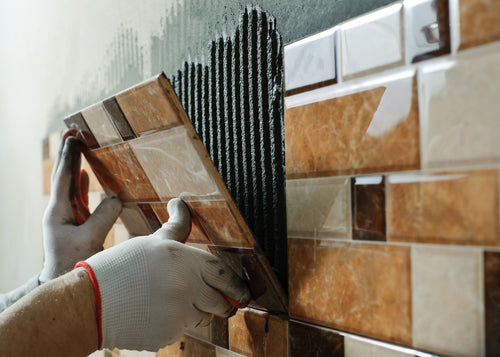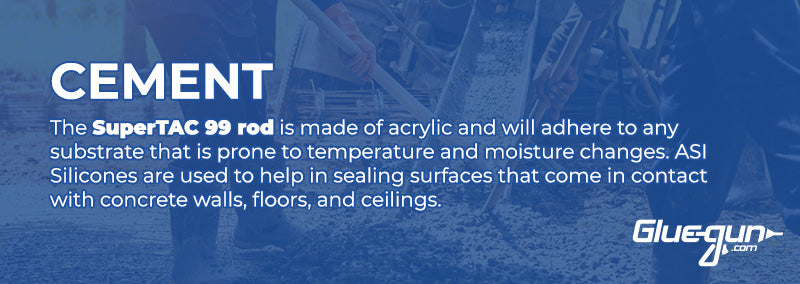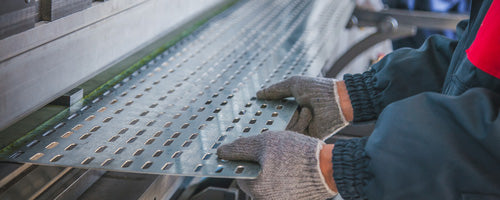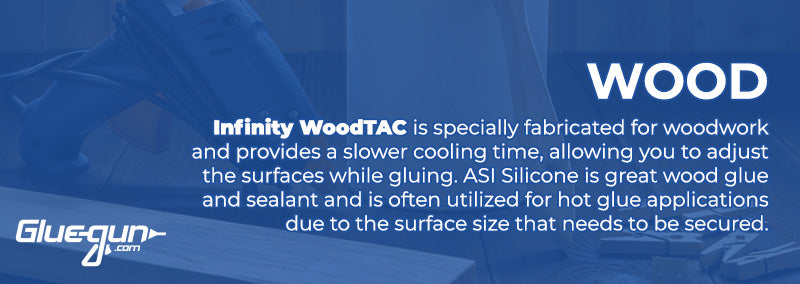Building and construction are some of the largest market areas for adhesives. They are used in a wide range of construction applications, such as roofing, tiling, carpet and flooring, drywall lamination, heating, ventilation and air conditioning, as well as many others, including bonded houses.
Bonded houses are homes which are made of timber and glued together. A single-component polyurethane adhesive is used. It is invisible and environmentally safe. State-of-the-art timber apartment building Chesa Futura in Switzerland, uses adhesives without solvents or formaldehyde, for a truly eco-friendly structure.
But what other construction adhesives are used in the construction industry? Deciding which material to apply when using a hot glue gun is the key to success. The choice of adhesive is based on the materials that need to be bonded together. Therefore, it is imperative you fully understand the different adhesive materials you can load into your glue gun.
One of the most important issues any glue user will encounter is choice: choice of gun and choice of glue. Rather than start to combat this question with hours of research, we have prepared a glue guide for you to read.

This is a quick guide to finding the best product for your job. There are three ways to approach the application of glue types, either concentrate on the glue, on the substrate to be glued, or on the size of the surface to be glued. There are many adhesive types; we find it best to choose the right adhesive by looking at the different materials being bonded and assigning the best adhesive product for each material type:
Carpet is glued to various surfaces with many different materials, which is why you will need a multi-purpose adhesive to secure it properly. The best solution is to use Infinity Tough Guy hot melt, which is a “stick-to-anything” solution. This glue will provide a strong bond between the carpet’s undercover and the floor surface, irrespective of either material type.

Cement is a porous substance that requires a highly versatile glue that does not detach when the temperature or the moisture content changes or fluctuates. That is why Infinity SuperTAC 99 is the best solution for this surface material. The SuperTAC 99 rod is made of acrylic and will adhere to any substrate that is prone to temperature and moisture changes. ASI Silicones are used to help in sealing surfaces that come in contact with concrete walls, floors, and ceilings.
Fabric is a different kind of material to glue and is replacing standard building materials in the construction industry. Among the most popular adhesives for fabric are Infinity SuperTAC 44, SuperTAC 55, SuperTAC 88, and Infinity Mighty Joe. Each one of these glue sticks will provide a perfect bonding solution for all fabrics.
Foam can be hard to glue due to its "spongy" nature. This is why you need a glue that is both versatile and strong when bonding foam to any surface. The best solution for foam bonding is Infinity SuperTAC 44 and all glues in the Infinity Mighty Joe range. ASI Silicone is a great material to use when bonding large foam areas to wooden surfaces.

Metal surfaces present challenges when you are bonding different materials to metal or metal to metal. You will need a glue that sticks to different metal surfaces. Take into account that some metals are harder to bond than others. The best solutions for gluing metal include Infinity Joe Tough Guy, Infinity SuperTAC 11, SuperTAC 44, SuperTAC 88, and SuperTAC 99. SuperTAC 11 and 88 are special adhesives formulated to bond the most adhesive resistant surfaces, especially metal. Another great glue option is ASI Silicone, which is great for securing large metal surface areas and sealing seams that require waterproofing.
Plastic can be confusing; some plastics can be glued easily and others act like metal and resist glues. Use an adhesive-resistant glue that tackles the most stubborn plastic surfaces. The best options for plastic include Infinity SuperTAC 11, SuperTAC 500, Tough Guy, and Mighty Joe. SuperTAC 500 is the best plastic adhesive around, and it is designed specifically for plastic surfaces of all types. ASI Silicone is a great product for bonding most plastics.
Vinyl is PVC, and it is found in flooring and outdoor sidings on houses. Gluing PVC is easy with the right product. As such, you can choose all the Infinity SuperTAC versions, as well as any Tough Guy and Awesome Joe glue. Just look at the other surface to which you are gluing the vinyl and pick the one that suits that surface.

Wood is another surface on which many types of glue can be used. However, you will get the best results when using Infinity WoodTAC, SuperTAC 11, SuperTAC 44, and SuperTAC 99. Infinity WoodTAC is specially fabricated for woodwork and provides a slower cooling time, allowing you to adjust the surfaces while gluing. ASI Silicone is great wood glue and sealant and is often utilized for hot glue applications due to the surface size that needs to be secured.
Ceramics and Glass are not as hard to glue as you would expect. Most of the Infinity hot glue solutions will work well with these surfaces, especially SuperTAC 11 and Tough Guy. These surfaces are both micro-porous and have an affinity to certain glues. ASI Silicones provide great gluing and waterproofing solutions for large ceramic surfaces.
Now that we have had a quick overview of the materials, let's take a look at the best adhesives options that are available to you:
Infinity Tough Guy
Trade Secret: This is the toughest glue available. This glue’s formula is a trade secret held in a secure vault. Without a doubt, this adhesive is incredible. With an application temperature range between 380°-420° F, sealed heat resistance to 300° F, and a non-toxic formula, this is one of the most versatile glues around and is great for most surfaces. Pair the Tough Guy with our best selling high temp hot melt glue gun, Infinity Bond Scout HT. When in doubt, Tough Guy will be your solution.
Infinity Bond PUR
PUR is Polyurethane PUR Hot Melt and is a general description for many polyurethane hot melt types of glue, including WW60, which is wood-to-wood glue; MP75, which is used to bond many substrates with smooth surfaces; and the PUR WW 30 wood-to-wood glue. The PUR class requires a PUR gun; this means that if you do not normally glue wood to wood, you should consider using the standard hot glue guns instead.
Infinity SuperTAC 11
This is another great general-purpose adhesive that provides a solid solution to many substrates. This glue has an application temperature range between 380°-420° F and a sealed heat resistance to 300° F, and it is fast setting. If you don’t have any Tough Guy, this is the one to turn to.
Infinity SuperTAC 44
This is a low-temperature glue that is great for wood, fabric, plastics, and even some light-gauge metals. This glue has an application temperature range between 265°-350° F and a sealed heat resistance to 190° F, and it is medium/slow setting, allowing you more time to align the surfaces. The low-temperature setting range allows you to apply this glue to sensitive surfaces, including paper and foam. Try SuperTAC 44 with the Infinity Bond Ranger PRO Adjustable Temp Hot Melt Glue Gun.
Infinity SuperTAC 55
If you need a fast-setting light material glue, then this is your best option. This glue is great for fabric applications. This glue has an application temperature of 350° F and sealed heat resistance to 200° F, and it is medium- to fast-setting. This glue is used widely in the packaging industry on cardboard.
Infinity SuperTAC 88
This is the glue you want for non-porous surfaces. This includes all plastic, metal, ceramic, and glass surfaces. This glue has an application temperature range between 340°-375° F and a sealed heat resistance to 205° F, and it is slow- to medium-setting. It is highly popular in furniture assembly and POP display fabrication.
Infinity SuperTAC 99
When it comes to substrates that have temperature and moisture issues, such as concrete floors, stone walls, and such, this is the best glue solution you will find. This glue has an application temperature range of 350° F and a sealed heat resistance to 195° F, and it is long-setting. The amazing ability of this glue to adhere to concrete is awe-inspiring, even when there is a case of flooding or extreme temperature changes such as in desert housing or humid climates—this is the glue to use.
Infinity SuperTAC 500
This is the king of plastics. If you need to glue anything plastic, don’t look any further, just apply this and sit back. This glue has an application temperature of 350° F and sealed heat resistance to 214° F, and it sets in 20 seconds. This glue is very popular in the construction industry.

Trade secret: Infinity products are the professional's preference and one of the market’s leading hot gun adhesives. This comes from a company that specializes in all things glue.
Another consideration when choosing your hot glue adhesive is the gun you are using. Remember, there are many hot types of glue, PUR glue guns, and ASI Silicone guns to choose from. The choice is always going to be dependent on the surface size you need to apply. Hot guns and PUR guns are best suited for smaller and more accurate applications, while ASI Silicone guns are best used for larger surface applications.
Another consideration is reach. In many construction and refurbishing environments, it is easier to apply silicone, while, in industrial assembly lines, especially in electronics and fast assembly lines, hot glue is the preferred tool of choice due to the speed in which it sets.
Special Insider Secret Revealed:
There is another type of glue that does not use a hot glue gun, and this is the ASI silicone sealant. The ASI silicone products are extremely versatile and are all applied using a standard silicone gun. There are many variants.
However, the basic difference between silicone and hot glue is the application temperature range. ASI silicone glues can be applied in ranges from below freezing to room temperature. They tend to set (skin over) in ranges between 30 minutes to two hours. Some ASI silicone products will withstand set temperatures of up to 310°C (600°F).
The end product differences are that ASI silicones are waterproof and highly flexible, so they all stand up to temperature fluctuations, as well as handle different surface movements and buckling very well.
Bottom Line: What to Choose?
Confused? Don’t be. There are rules to guide you. The first rule is the frequency of use. The second is for application purposes, and the third is ease of use.
Most non-professionals will use silicone for any application since ASI Silicone is easier to apply and is applied in frequent successions (although the gun size is bulkier), and it has multiple application purposes. The downside of silicone adhesives is that they can be messier in the long run; they take much longer to set than hot glue, which is not efficient in industrial applications; and they usually are used for larger surfaces.
Hot glue guns are used for a variety of purposes that are less flexible in nature than silicone—for instance, packaging materials will be sealed using a hot melt gun and not a silicone derivative. Securing small wires to PCBs and other small assemblies necessitate using the more flexible and lighter hot glue gun, especially since they set much quicker.
![]()
To Sum Up:
- Hot glue sets faster, the gun is smaller and more flexible for use, and it can be applied to even the smallest tasks with ease. Although used in construction, hot glues are also great for hobbyists for fast accuracy and for commercial assembly and packaging lines.
- Silicone is best used for large surfaces and can be used for waterproofing as well as gluing, but it takes longer to set. It is used in construction and home improvement as well as some assembly lines.

